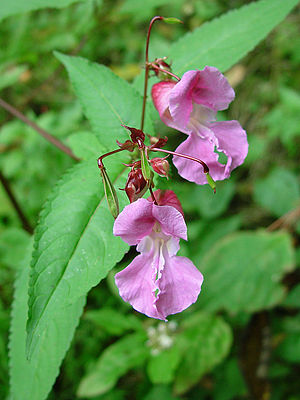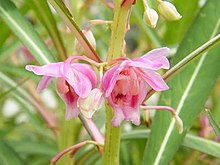Balsamic plants
| Balsamic plants | ||||||||||||
|---|---|---|---|---|---|---|---|---|---|---|---|---|

Glandular balsam ( Impatiens glandulifera ) |
||||||||||||
| Systematics | ||||||||||||
|
||||||||||||
| Scientific name | ||||||||||||
| Balsaminaceae | ||||||||||||
| Bercht. & J. Presl |
The plant family of the balsamic plants (Balsaminaceae or rarely also called Impatientaceae) belongs to the order of the heather-like (Ericales).
Description and ecology
The balsamic plants are annual or perennial herbaceous plants with translucent, fleshy tissue in the stems . The plant parts are mostly bare. The alternate and spiral or usually opposite, rarely in threes in whorls arranged leaves are simple and stalked. Teeth or cusps that can secrete nectar (extra-floral nectaries ) are often formed on the petiole and on the leaf margin . The leaf margin is smooth or often finely and sharply serrated. Stipules can usually not be observed.
The flowers are solitary or in zymose inflorescences .
The strongly zygomorphic , five-fold, hermaphrodite flowers rotated by 180 degrees are characteristic . Of the three to five sepals , the middle one is greatly enlarged, mostly spurred and similar in color to the petals. In many species the spur is rounded sack-shaped. Two of the other four sepals are well developed, the last two often tiny or absent. Of the five petals (rarely four) , one is enlarged and forms the upper lip of the flower. The other four are fused in pairs to varying degrees ( still free in Hydrocera ) and form a lower lip consisting of two parts. The exact shape and color of the petals and sepals vary greatly depending on the species. There are many extremely decorative species that are used as ornamental plants. The flowers of the Hydrocera genus are not quite as zygomorphic as those of Impatiens , but the features mentioned here still apply in a weakened form.
There is only one circle with five free, fertile stamens , they are clearly unequal and the inner stamen circle is missing. In each flower (rarely four) five are Fruchtblätter a top permanent ovary grown. The style ends in one or five pits. The pollination is usually by insects ( Entomophilie ).
In Impatiens , capsule fruits that pop open explosively are usually formed, and in Hydrocera stone fruits .

distribution
The main distribution centers of the family are the mountain regions of tropical and subtropical Africa , especially Madagascar and South Asia. Most species of the genus Impatiens prefer locations with a balanced water balance and occur along banks or in damp forests. There are only a few species in the temperate latitudes of the northern hemisphere . Some species are neophytes in many areas of the world .
Systematics
The family contains about 1000 species in only two genera:
- of the large genus of spring herbs ( Impatiens L. )
- and a monotypic genus Hydrocera Blume ex Wight & Arn. with the only kind:
- Hydrocera triflora (L.) Wight & Arn. which occurs in Southeast Asia and Malesia .
swell
- The family of Balsaminaceae in APWebsite (English)
- The Balsaminaceae family at DELTA. (English)
- Family description in the Flora of China. (English)
- David Moresby Moore: Impatiens L. In: Thomas Gaskell Tutin u. a .: Flora Europaea . Volume 2, pages 240-241. Cambridge University Press 1968
